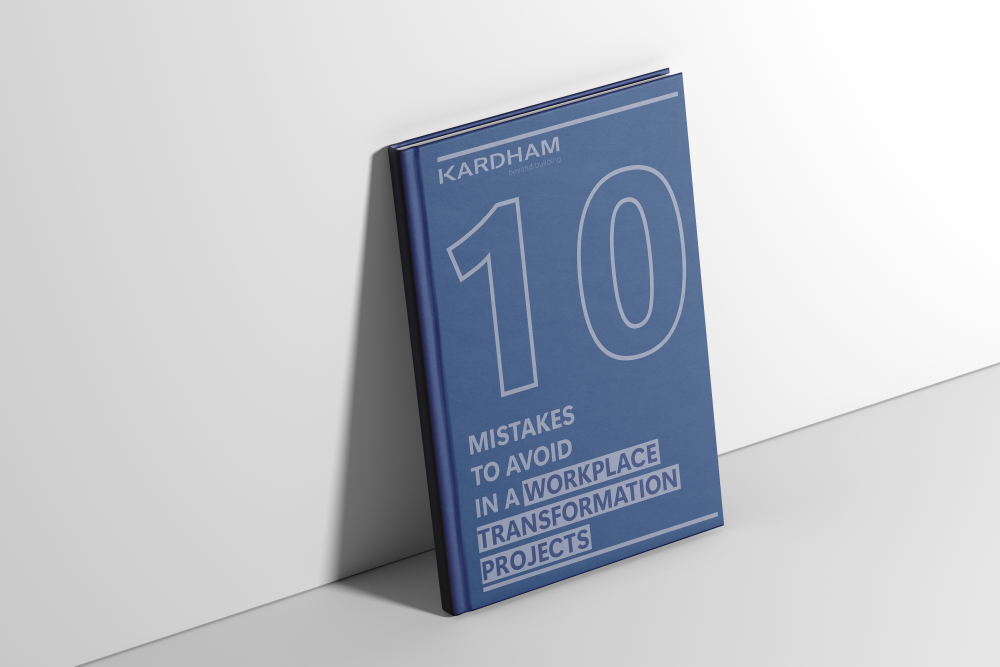- Home
- EN
- Kardham Group
- News
Workplace projetcs : the 10 mistakes companies must avoid
June 2025

Kardham unvails new white paper : 10 mistakes companies must avoid in a workplace transformation project.
Following the success of its widely shared “10 Myths About the Workplace”, Kardham’s R&D department, led by Nicolas Cochard, releases a bold new edition in its “TOP 10” series. Titled “10 Mistakes to Avoid in a Workplace Transformation Project”, this new white paper offers a sharp, strategic framework to help companies navigate the most common – and costly – pitfalls in spatial transformation. The central takeaway? While workplace transformation has never been more urgent, companies must remember: transforming a space means transforming an organization. And more than a real estate project, it's a human, political, and cultural endeavor.
Space is culture
Workplace transformation isn’t about surface area or trendy design — it’s about how a company works, collaborates, and evolves. That’s the message at the heart of this white paper. Far from a generic checklist, the paper dissects the hidden risks behind spatial projects and makes a compelling case for tailor-made work environments — ones that align economic efficiency with employee needs, organizational culture, and the new demands of hybrid work.
Blending real-world experience with academic insight, the paper is the result of continuous dialogue between field experts and researchers. Aimed at C-suites, HR leaders, corporate real estate teams, transformation managers, architects, and consultants, it identifies 10 critical errors to avoid, each backed by practical, field-tested recommendations — all to help decision-makers move beyond functional thinking and toward strategic, human-centered transformation.
5 (out of 10) workplace transformation mistakes that can be costly
Mistaking speed for haste
Moving fast is not the same as moving smart. Rushing a project without giving teams the time they need to adjust can weaken buy-in and create lasting discomfort. Transforming a workplace often triggers a phase of despatialization — a loss of bearings, disorientation, a sense of insecurity. Without time dedicated to respatialization, change is something endured, not embraced, and becomes counterproductive. Trying to change everything overnight is a major trap. Because we all know that changing the set without rewriting the script is a recipe for failure.
Lacking a Clear North Star
Without a compass, even the best teams end up going in circles. A spatial transformation project without a clear vision and shared ambition lacks direction and breeds confusion. Whether it's the absence of a participative, horizontal transformation framework — or, conversely, an overly directive, top-down one — misunderstandings, rumors, and frustrations thrive. Leading a transformation project means anchoring it in a clearly defined and widely shared vision, consistently and effectively communicated, so it can spread as homogeneously and coherently as possible. Because you can’t rally people without meaning, and you can’t transform without taking them with you..
Ignoring Company Culture
One-size-fits-all design doesn’t work. Organizations each have their own cultural identity: some are cutting-edge, others more traditional; some lean vertical, others horizontal; some value autonomy, others control. Ignoring these traits is a critical mistake. Designing a workplace without integrating the cultural dimension risks producing an environment that feels out of touch — or even rejected. Space is never neutral: it mirrors how people work, collaborate, and connect. Skipping the cultural lens means forgetting you’re designing for real human communities. And a space that doesn’t resonate with its users will never be truly lived in.
Confusing Equality with Equity
Fair doesn’t always mean identical. In a transformation project, offering identical spaces to everyone may seem easier… but is rarely relevant. Work styles, job roles, and employee profiles are all different — and so are their needs. Equity means acknowledging this diversity and responding accordingly. Ignoring that is a fast track to creating workspaces that satisfy no one. Because no matter how well-designed a volleyball court is, it will never work for a handball team.
Forgetting That a Workplace Is… for Working
In the media and on social networks, the workplace is often presented through the lens of modernity and flexibility. But it's worth remembering that the number one factor in workplace satisfaction is simply this: its ability to enable good work. In the race to make offices “inspiring,” we sometimes forget their primary function: helping people get things done. A pleasant space, yes — but above all, one that is useful, fit-for-purpose, and efficient. Hybrid work has reinforced the social value of the office, but we must not lose sight of the basics: concentration, autonomy, individual productivity. A beautiful space poorly designed is still a constraint. Because a place where you can't actually work will eventually be abandoned..
Read all 10 mistakes to avoid in workplace transformation projects here
« When you seek to transform an organization’s space, you set off a chain reaction: the workplace is simultaneously a tool for work, a structural mechanism, a territorial anchor, and an expression of identity. Transforming a workspace is never a neutral act - it goes to the heart of how people work, how institutions are structured, and how identity is expressed. Above all, it affects people. Too often, these psychosocial and intangible aspects are underestimated or ignored in favor of overly economic approaches. With this new white paper, we wanted to share insights drawn from both fieldwork and academic research, to help project leaders find the right balance between all these dimensions. By blending scientific and operational perspectives, we hope to help them avoid some frequent, often invisible—but always impactful—mistakes. A workspace isn’t just a functional location. It’s a strategic lever, a management tool, and a cultural medium. As such, it must be designed with method, purpose, and depth.» - Nicolas Cochard, R&D Director, Kardham Group

